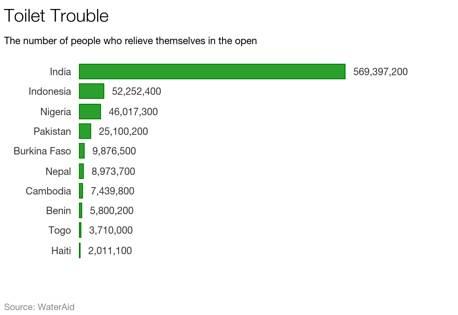India Has the World’s Longest Line for the Toilet
If the 774 million people living without a household toilet in India stood in line, they would stretch from the Earth to the moon, and maybe beyond, a report released to mark World Toilet Day showed Thursday.
Clearing the line would take at least 5,892 years, if each person took a minimum of four minutes to use the toilet, according to the report by WaterAid, a water and sanitation nonprofit headquartered in London said.
India continues have the largest number of people without toilets at home and the highest number of people defecating in the open, the report titled, “It’s No Joke: The State of the World’s Toilets 2015,” says.
But despite this, it doesn’t feature in the list of 25 countries with the least safe and hygienic latrines per person. India, though, is far from out of the woods in terms of safe toilet habits.
More than 770 million people in India still don’t have access to improved home toilets, more than double China’s 329 million people who don’t have a toilet in their house.
And nearly half of India’s population–569 million people–relieve themselves in the open, sometimes even when public facilities are available.
People in rural areas often go out in the open because of habit or cultural preference. Some villages feel toilets are meant for old people, newly-married girls or children, others believe open defecation is a way of staying fit because people worldwide defecate in the open and India has the highest concentration of them — 173 people go outside for every square kilometer.
“That ratio would be the same as 500 people having to defecate in the open in the Square Mile of the City of London, or 15,000 people in Manhattan, New York City,” the report said.
India’s neighbors have far fewer people defecating in the open, with 61 people a square kilometer in Nepal going outside and 32 people a square kilometer in Pakistan.
A lack of proper sanitation in India poses a serious threat to the health of children, where hundreds of thousands die every year because of diseases transmitted through human waste.
More than 140,000 under-fives die in India each year from diarrhea, according to the report. Nearly 40% of children are stunted, when height falls short of that expected for a child’s age, affecting their life chances. And the country also has high rates of maternal and newborn mortality linked to sepsis or infection as a result of open defecation.
Women who go into fields in the early mornings or late at night to defecate are also vulnerable to sexual assault or attacks by wild animals, the report found.
Prime Minister Narendra Modi last year launched the Swachh Bharat Abhiyaan or Clean India Mission to, among other things, eradicate open defecation and build an indoor toilet for every home by 2019.
But simply building the toilets won’t be enough.
“What will be absolutely crucial is getting local, state and national government to make this a priority, and creating the cultural shift that will ensure that once the toilets are built they are used – by everyone,” the WaterAid report added.
Photo Caption: The number of people who relieve themselves in the open
Related Posts

